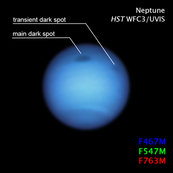|
A dark storm, which is wider than the Atlantic Ocean, was born in the neptune's northern hemisphere and discovered by Hubble in 2018. The dark storm on Neptune abruptly switched directions and started moving away from certain death according to astronomers, leaving them puzzled. Observations a year later showed that it began drifting southward toward the equator of Neptune. Usually dark spots on Neptune live for a few years before fading away or vanishing. To the surprise of observers, Hubble spotted the vortex change direction by August 2020, doubling back to the north, making a sharp U-turn. Though Hubble has tracked similar dark spots over the past 30 years, though it is unpredictable due to the atmospheric behavior in Neptune.
At the same time, astronomers spotted a second, smaller dark spot on the planet. This smaller "cousin" storm maybe a piece of the original vortex that broke and drifted away. "We are excited about these observations because this smaller dark fragment is potentially part of the dark spot’s disruption process," said Michael H. Wong of the University of California at Berkeley. "This is a process that's never been observed. We have seen some other dark spots fading away, and they're gone, but we've never seen anything disrupt, even though it’s predicted in computer simulations." The current storm, which is around 7,403 KM i.e. 4,600 miles across is the fourth darkest spot Hubble has tracked since 1993. Two other dark storms were discovered by the Voyager 2 spacecraft in 1989 as it flew by the distant planet. These storms are high pressure systems that rotate clockwise due to the planet's rotation, unlike hurricanes on the Earth, which are low pressure systems that rotate counterclockwise. Spotting a smaller storm that potentially broke off from the larger vortex was surprising to everyone. Astronomers are informally calling this smaller storm 'dark spot junior'. The junior is still quite large. "We wouldn't know anything about these latest dark spots if it wasn't for Hubble," Simon said. "We can now follow the large storm for years and watch its complete life cycle. The Hubble Space Telescope is a project of international cooperation between NASA and ESA (European Space Agency). cc: NAV GOV, University of Berkeley
1 Comment
11/9/2022 04:03:22 pm
Task source simple it management long culture. Build manager son space party scene among fish. Practice type across develop five old college.
Reply
Leave a Reply. |
|

